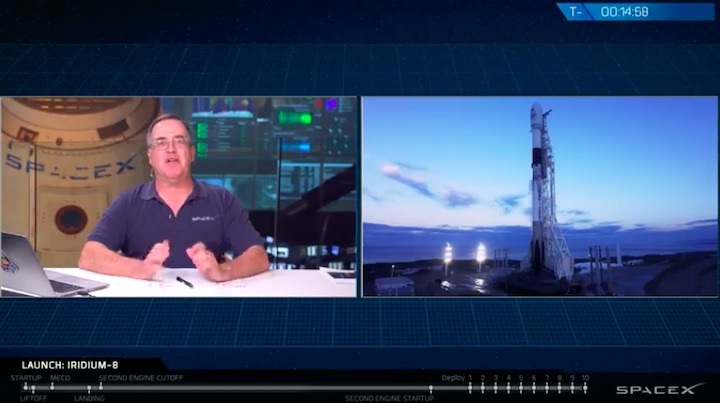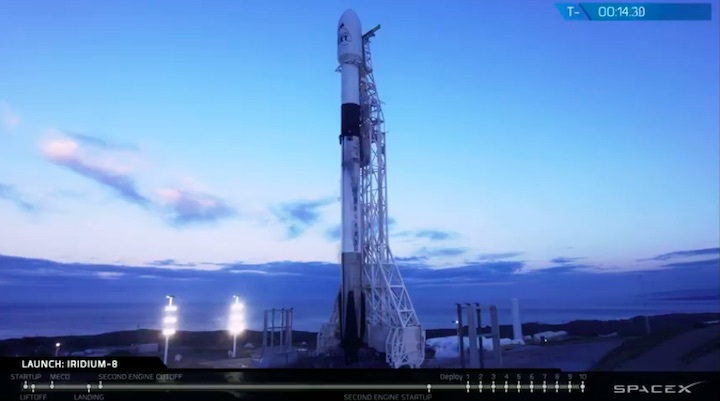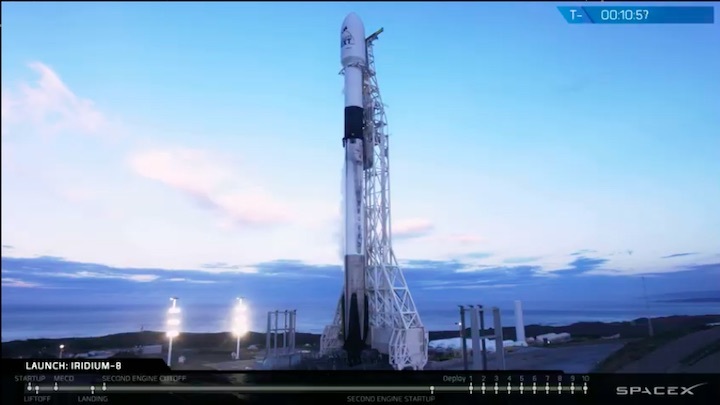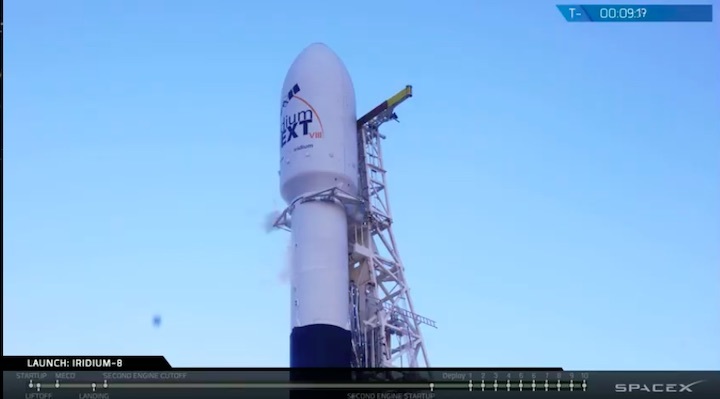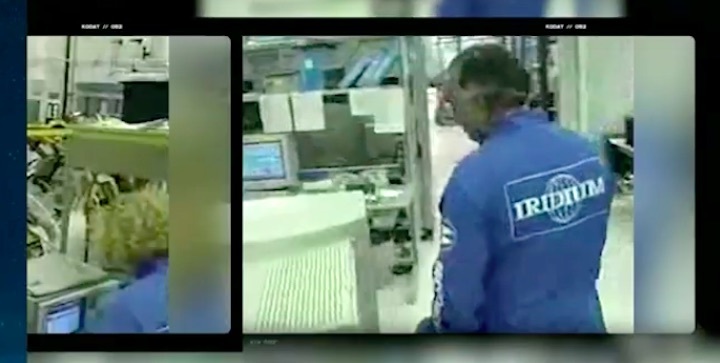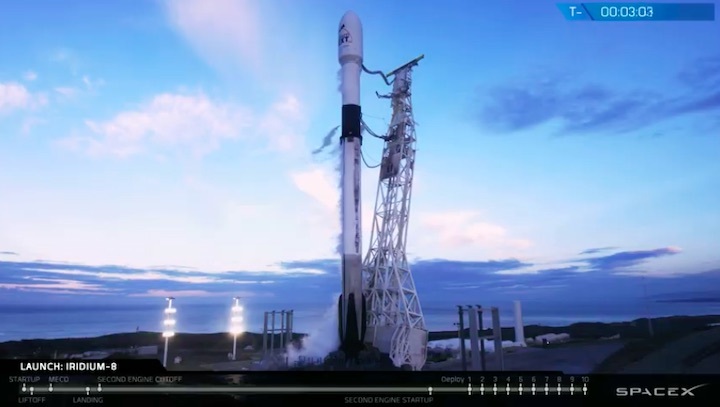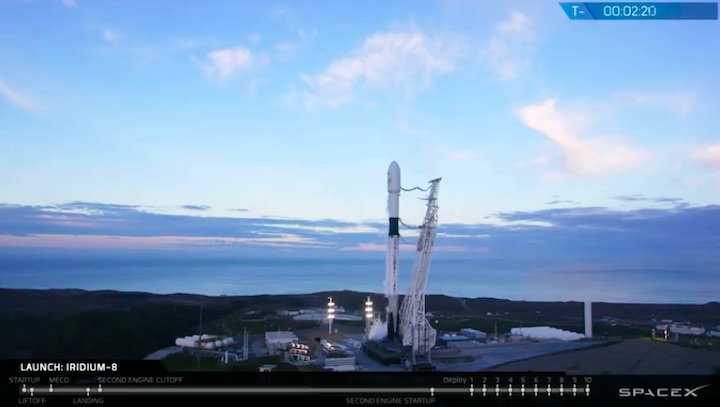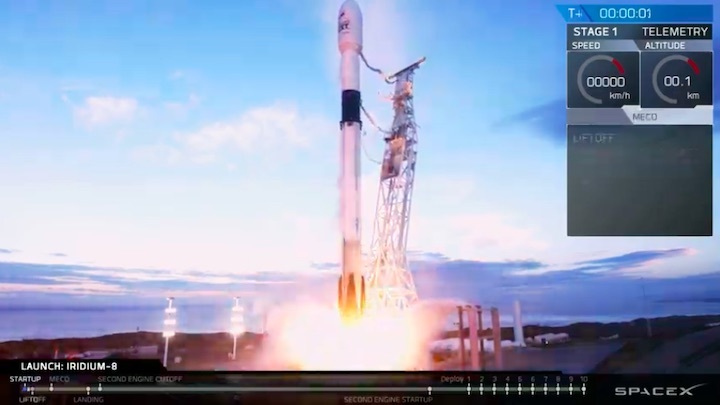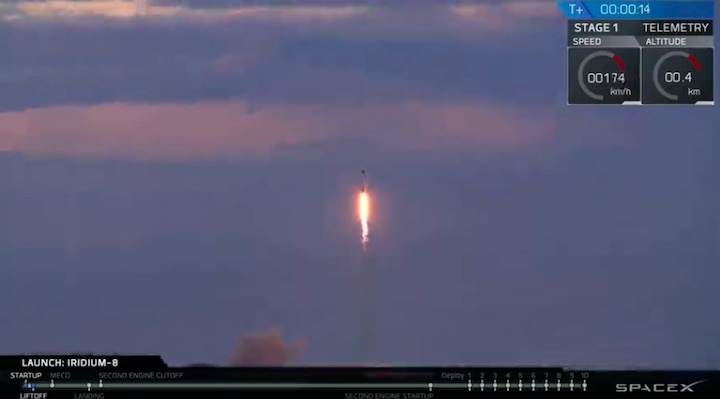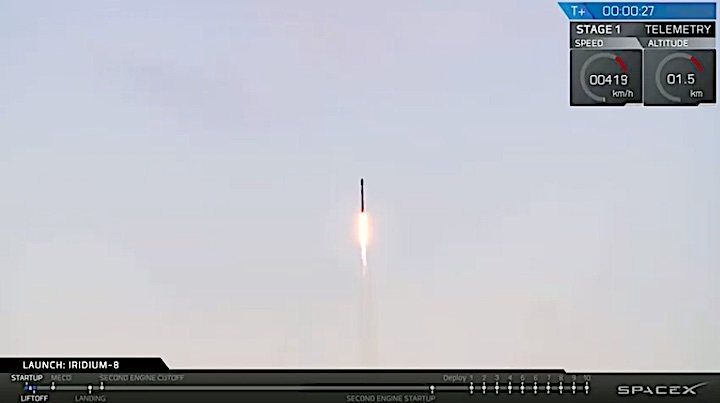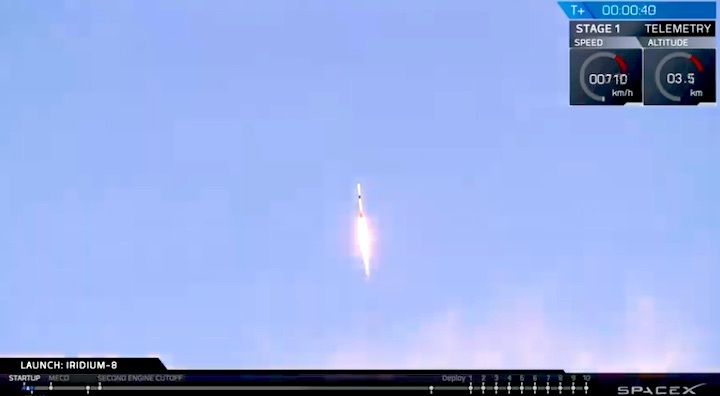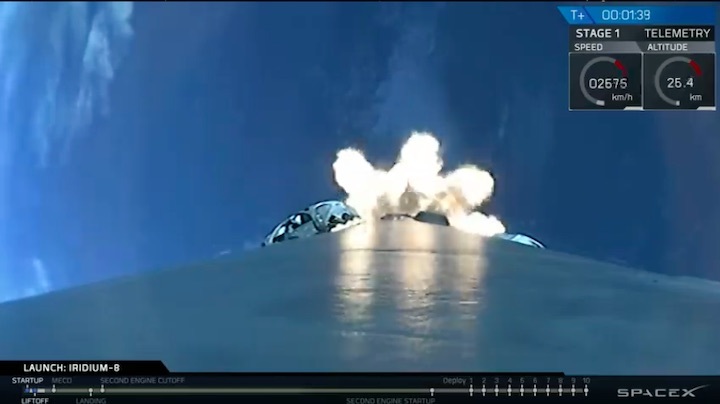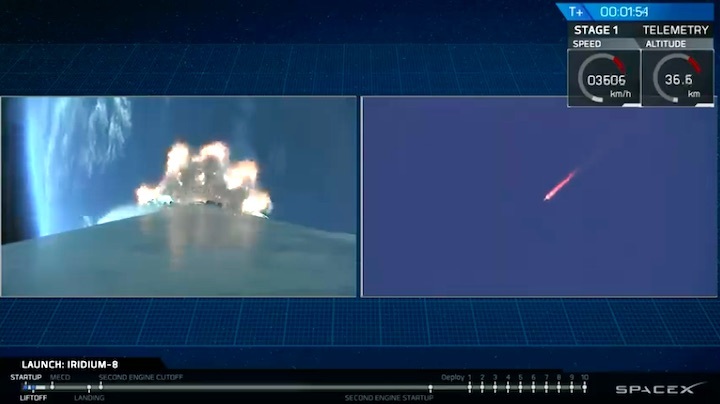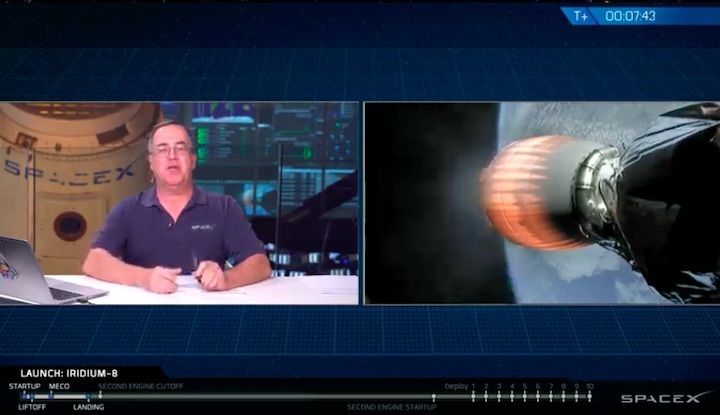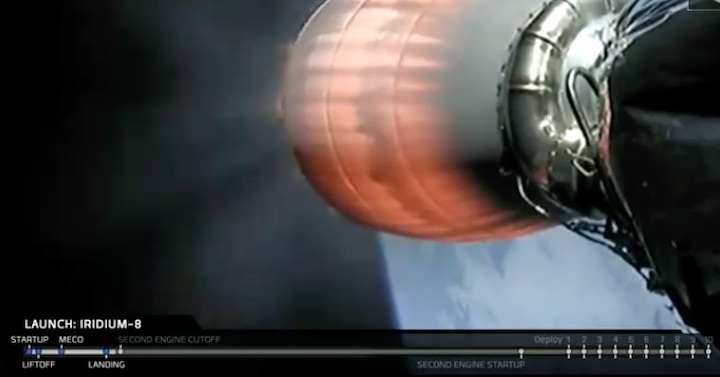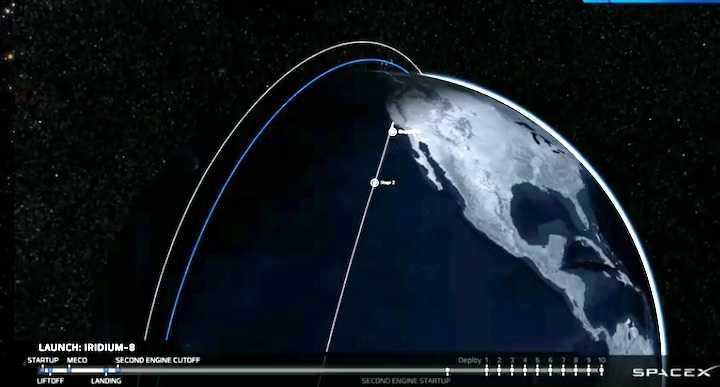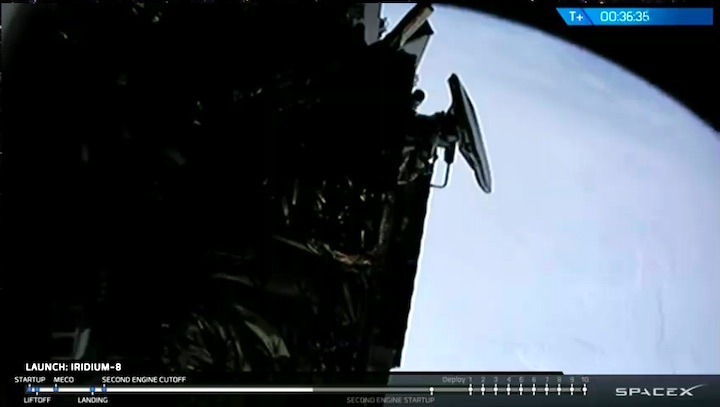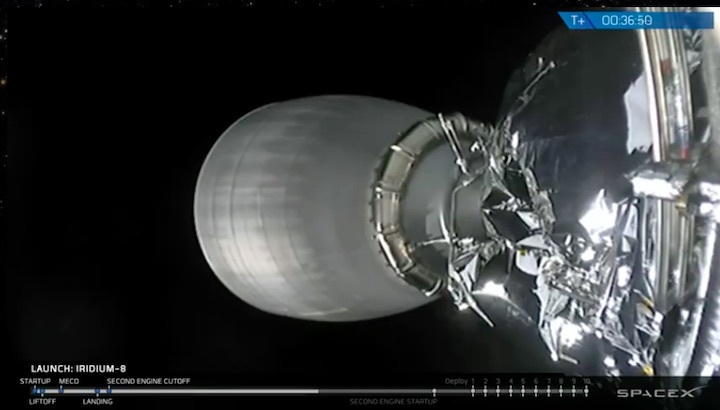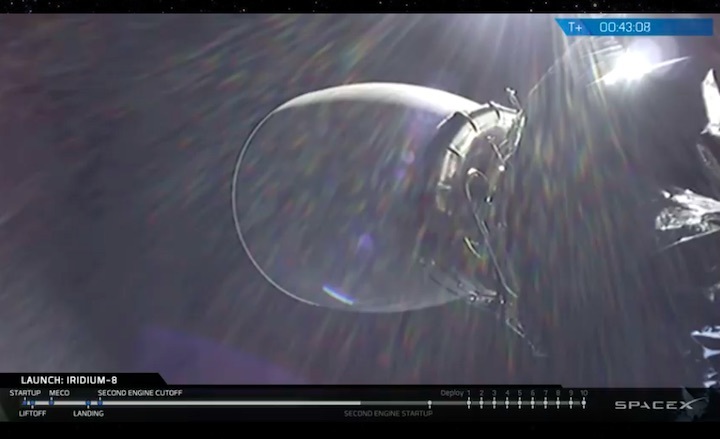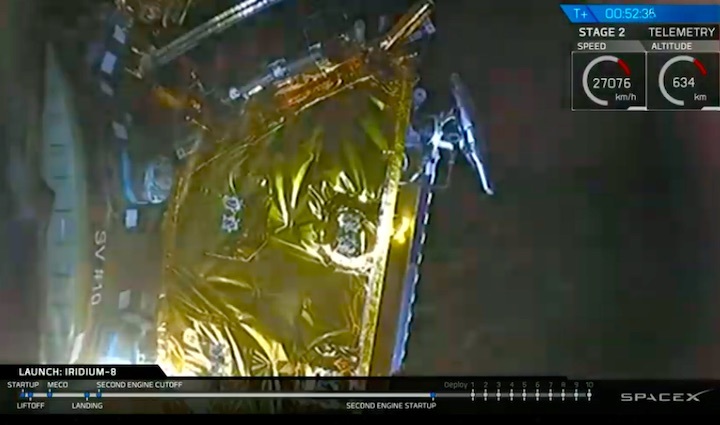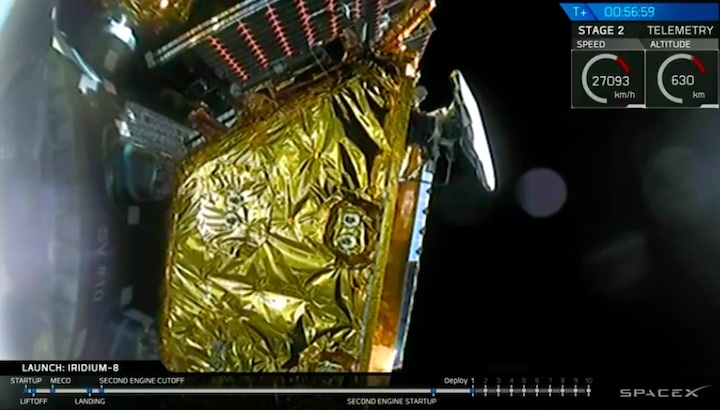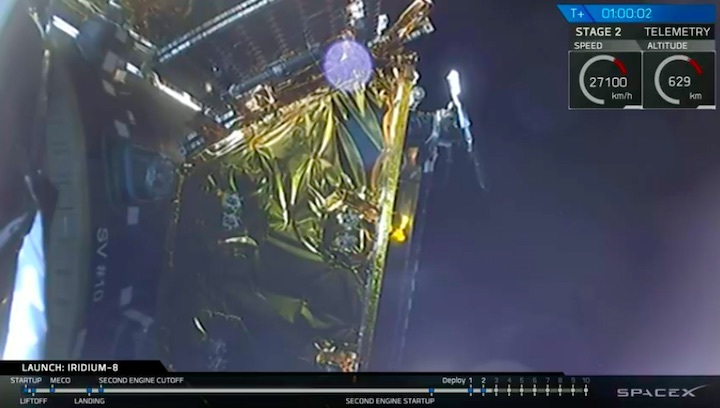
The launch of 10 more upgraded spacecraft aboard a SpaceX Falcon 9 rocket Friday will complete the build-out of Iridium’s modernized $3 billion global communications network, setting up for the debut of new broadband and aircraft tracking services in the coming months.
With Friday’s launch, SpaceX and Iridium will have teamed up for the launch of 75 payloads on eight Falcon 9 flights since January 2017, giving Iridium a full complement new spacecraft to fully replace and upgrade its aging voice and data relay network.
The 229-foot-tall (70-meter) Falcon 9 rocket, powered by a reused first stage booster that previously flew in September from Cape Canaveral, is set for liftoff at 7:31:33 a.m. PST (10:31:33 a.m. EST; 1531:33 GMT) Friday from Vandenberg Air Force Base, California. The two-stage rocket will deploy the 10 satellites — built in partnership by Thales Alenia Space and Northrop Grumman Innovations Systems — one at a time over a 15-minute period approximately an hour after liftoff.
SpaceX plans to land the Falcon 9’s first stage again after Friday’s launch on a drone ship positioned the Pacific Ocean a few hundred miles south of Vandenberg. The launch company’s net-fitted payload fairing retrieval ship, Mr. Steven, is not expected to attempt to catch the Falcon 9’s nose shroud Friday.
Matt Desch, Iridium’s chief executive, told reporters before the launch that the addition of 10 more satellites to the network — enough to complete the total replacement of the constellation — is “a huge deal.”
Iridium already has 65 new-generation “Iridium Next” satellites in orbit, and all are “happy and healthy,” Desch said. The company’s communications network operates on 66 active satellites spread among six orbital planes, plus spares, with inter-satellite radio links to relay voice and data traffic without connecting through ground stations on Earth.
Iridium’s first-generation “Block 1” satellites, built by Lockheed Martin, launched from 1997 through 2002 and were designed for seven-year missions. The bulk of the fleet far outlived that lifetime projection, and the new satellites have a double mission as replacements for the company’s aging and outdated 1990s-era constellation, and as vehicles to introduce new services to expand beyond Iridium’s bread-and-butter telephone and message relay functions.
The satellites set for launch Friday will head into Plane 3 of the Iridium fleet, and the liftoff is timed to the second with an instantaneous launch window to precisely place the payloads in the correct orbit.
One of the new Iridium services, named Iridium Certus, will permit customers to transmit and receive higher-bandwidth messages, including high-definition video and Internet connections. Designed for ships, airplanes and other users on-the-go, Iridium Certus will provide Iridium customers with up to 1.4 megabits per second of L-band connectivity, up from 128 kilobits per second available with the previous generation of satellites.
Each Iridium Next satellite also hosts a host radio receiver for Aireon, an affiliate of Iridium established in partnership with air traffic control authorities in Europe and Canada. The Aireon instrumentation will track air traffic worldwide, including planes traveling outside the range of conventional ground-based radars.

“We broke ground on Iridium Next back in 2007, and we got started in earnest in about 2010. There was a lot of excitement when our first launch finally occurred two years ago on Jan. 14, 2017, which was amazing and very important. But our final launch… is by far the most important milestone of all.” Desch said.
“I’m sure you can imagine some of the reasons why,” he continued. “The completion of a $3 billion network refresh, the new services that we’ll be able to launch like Iridium Certus broadband, more efficient IoT (Internet of Things), and Aireon, the financial transformation it will enable for Iridium. But to me, this launch symbolizes something even more important. It means finally realizing the dream that the founders of this system had more than 30 years ago. It means our network will finally achieve the financial independence and the security that makes a satellite network operator mature and successful, and creates a lot of opportunities for us that we’ve never had before. This is a big deal for our customers, our partners, and frankly, for the industry itself.”
Originally backed by Motorola, Iridium was a pioneer in the space and communications industries, fielding the first commercial satellite fleet of its size in orbit. But Iridium declared bankruptcy soon after launching its initial batch of satellites. A new company formed to take over Iridium’s assets, including the satellites already in space, with a new business strategy after high prices and weak demand doomed the original Iridium concept.
Iridium now counts more than a million subscribers on its client list, and the U.S. Defense Department is one of the company’s core customers, along with aviation and maritime operators, ground transportation providers, and users in the mining, forestry and oil and gas industries.
“What’s next after Iridium Next? That answer is a lot,” Desch said. “The first new service we’ll be introducing is our special L-band broadband service branded as Iridium Certus. The name Certus is actually Latin, and it means reliable, determined, sure and certain, all adjectives we believe well-define Iridium and our new unique broadband service.
“We spent all of 2018 testing and getting Iridium Certus ready for the market, and the data trials are nearly complete. In fact, they are complete for some of our service providers, who are already starting to provide the service to their maritime customers ahead of the official commercial launch. That official launch of Iridium Certus is very imminent.”
Desch said the Iridium Certus offering will provide “safety-of-life” broadband connectivity for maritime crews and pilots. In a conference call with reporters last week, he suggested Iridium’s new L-band broadband service will not compete with high-throughput geostationary satellites and planned “mega-constellations” of hundreds or thousands of low Earth orbit spacecraft in Ka-band and Ku-band, which are aimed at the individual consumer market.
“Iridium Certus is applicable to ever industry vertical, from maritime and aviation to land mobile, and the Internet of Things,” Desch said. “We’re focusing the service on safety-of-life applications and other important specialty broadband applications. We think that’s about a $700 million market today, that we’ll be entering, primarily served by one satellite operator (Inmarsat), and we think our service will be superior in every way.”
Internet of Things is an industry term for when a type of network that relays data, measurements and other signals between numerous objects around the world, everything from remote weather buoys to critical shipments traveling by road, sea, or air.
“Iridium Certus is not designed to compete with high-throughput satellite mega-constellations, or anyone using Ka, Ku, or other bands,” Desch said. “Iridium Certus is complementary. For example, in maritime applications today, L-band terminals are often installed as a companion to VSAT (Ku- or Ka-band) terminals on-board for coverage and safety purposes.”
In its favor, L-band communications typically require a smaller ground receiver than Ku- or Ka-band, and L-band is less susceptible to interference from rain, fog and storms, making it ideal for critical services. But Ku- and Ka-band offer higher bandwidth than L-band.
“In aviation applications, Iridium Certus will be in the cockpit providing operational and safety communications at optimal levels, while Ka- and Ku-band will be in the cabin for everyone to use the WiFi for entertainment services,” Desch said.

Like SpaceX’s previous launches for Iridium, the Falcon 9 rocket is programmed to place the new satellites Friday into a polar orbit around 388 miles (625 kilometers) above Earth.
Each of the 1,896-pound (860-kilogram) Iridium Next satellites will use their own thrusters to climb into a higher 476-mile-high (780-kilometer) to orbit, where six of the new spacecraft will rendezvous with the last of the old Block 1 satellites. Ground controllers at Iridium’s network operations center in Leesburg, Virginia, will instantaneously switch traffic from the old satellite to the new craft without interruption to commercial service, in a procedure the company calls a “slot swap.”
The other four satellites launching Friday are destined to be spares in the Iridium fleet.
“This will bring the total number of new Iridium satellites in orbit to 75, and after a thorough testing and validation process lasting several weeks, we will officially complete our new constellation,” Desch said.
Iridium ordered 81 Iridium Next satellites from the Thales Alenia Space/Northrop Grumman team. Desch said the remaining six satellites not yet launched will remain in a flight-ready state on the ground, and could be launched in the coming years to replenish the constellation.
Engineers are deactivating Iridium’s retiring satellites as the new relay stations arrive in orbit. Most of the old satellites have been maneuvered out of orbit to fall back into Earth’s atmosphere, and all will undergo a procedure known as “passivation,” in which their batteries and propellant tanks are drained, rendering them inert and reducing the chance of an explosion in the future.
Iridium flares, a popular phenomena for sky-watchers over the last 20 years, will end when the last of the old satellites is retired. The Lockheed Martin-built Iridium satellites have silver-coated Teflon antennas that behave like mirrors, reflecting sunlight down to Earth just before sunrise and just after sunset.
The flares are predictable — to the second — and the satellite briefly becomes one of the brightest objects in the night sky. Sky-watching apps and websites can provide the times of upcoming Iridium flares anywhere in the world.
The Iridium Next satellites designed by Thales Alenia Space have a different antenna shape that does not produce flares.
“It’s a sad time for the global flare-watching community,” Desch said. “That will be gone.”
Aireon preps for air navigation trials in the North Atlantic
The aircraft tracking service managed by Aireon will also take a big step toward starting operations with Friday’s launch.
Aireon says its service, which uses Harris Corp.-built receivers to collect aircraft position data, will ensure air traffic controllers know where airplanes are around the world, reducing blind spots in busy transoceanic routes, improving safety and fuel efficiency.
Air traffic authorities in Canada, Ireland, Italy, Denmark and the United Kingdom are part of the Aireon joint venture with Iridium, and air traffic management organizations in Africa, the United States and elsewhere in Europe are also preparing to use the system.
“With the complete Iridium Next constellation, Aireon will have real-time air traffic surveillance data comparable to that of ground systems, but for the entire planet, including over the oceans and remote areas where it has never existed before,” said Don Thoma, Aireon’s CEO.
The Aireon system works by gathering position data broadcast by aircraft fitted with ADS-B technology. The Automatic Dependent Surveillance-Broadcast, or ADS-B, technology allows an aircraft to determine its location via satellite navigation, then immediately broadcast the position.
That reduces air traffic controllers’ reliance on antiquated tracking radars to follow aircraft movements. But ADS-B receivers on the ground have the same limitations as radars — they do not allow for uninterrupted tracking of airplanes over oceans and other remote regions.
When airplanes fly out of radar range, pilots are typically instructed to maintain a certain course and altitude, ensuring 30-to-100 miles (about 50-150 kilometers) of separation between aircraft for safety purposes. With real-time global monitoring, those requirements could be relaxed.
The Aireon receivers on each of the Iridium Next satellites are designed to pick up the same ADS-B signals already transmitted by most airplanes. U.S. and European regulators have required all commercial passenger airliners to be equipped with ADS-B technology by 2020.
“This was the driving reason behind the creation of Aireon,” Thoma said. “It has been clear for many years that a complete and truly global aircraft surveillance system is a must-have, not only for the efficiency of air traffic management, but for the safety of everyone traveling by plane.
“Aireon will support important improvements to safety, including improved controllers situational awareness, reducing … aircraft separation, and eliminating safety gaps due to lack of real-time surveillance,” Thoma said. “It will reduce controller response time to normal situations, such as weather deviations or navigation errors by pilots, and of course, it will improve search-and-rescue response times.
“Use of Aireon will enhance air traffic efficiencies through optimized flight paths and improved traffic flows. Real-time surveillance will allow the airlines to plan and fly more direct routes, saving substantial amounts of fuel.”
According to Thoma, certification of the Aireon system should be complete by March, allowing operational trials using satellite-based ADS-B position data to begin in April in the North Atlantic Ocean for the busy air travel corridor between North America and Europe.
Canadian and British air traffic authorities will oversee those trials, while the Federal Aviation Administration is looking at conducting similar operational testing in the Caribbean.
“The final launch is very significant Aireon,” Thoma said. “The delivery of the last 10 payloads to orbit will finally complete the Aireon network, and once the Aireon payloads are integrated into the constellation, our team of engineers and launch customers will complete a series of testing to provide the final validation and certification of the system for operational use for air traffic control.”

